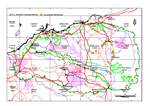Click on images
to enlarge



Photographer: B.R. Maslin

Photographer: B.R. Maslin
, BRM 4942, ORIGINAL SCAN, ADJUSTED RICHARD WOODMAN_sml.jpg)
Photographer: B.R. Maslin

Photographer: M.W. McDonald

Photographer: B.R. Maslin

Photographer: B.R. Maslin

Photographer: B.R. Maslin
, BRM 8648, lab photo by Fiona McCallum ADJUSTED_sml.jpg)
Seed from one herbarium voucher. Scale in mm. Photographer: F. McCallum.
Botanical name
Acacia eriopoda Maiden & Blakely, J. Roy. Soc. W. Australia 13: 27, pl. 19, figs 10-15 (1928)
Common name
Narrow Leaf Pindan Wattle (preferred common name) and Broome Pindan Wattle
Aboriginal name
Yirrakulu (Nyangumarta)
Description
Erect, well-formed, slender shrubs or small trees 2-7 (-8) m tall, either with a single trunk or dividing into a few (up to about 4) ascending to erect, straight main stems at or near ground level, canopy open to mid-dense and with a somewhat delicate aspect. Bark mid-grey to light grey, finely longitudinally fissured (somewhat flaking with age) on trunks and main stems especially towards their base, otherwise smooth. Branchlets glabrous. Phyllodes long and linear, (10-) 12-24 cm long, (1-) 1.5-5 mm wide (often not above 3 mm), very rarely to 10 mm wide, thin-textured, not rigid, ascending-erect or wide-spreading, straight to very shallowly incurved, glabrous, green (sometimes tinged grey) or yellowish green; parallel longitudinal nerves numerous, fine, very close together (space between the nerves normally about the same as nerve diameter), the central nerve more pronounced than the others; apex acute, not spiny. Inflorescences simple; peduncles 1-2 (-3) mm long, sparsely to densely hairy with normally wide-spreading hairs; spikes 2-5 cm long, light golden, densely flowered. Flowers 5-merous; calyx shortly dissected, the calyx tube densely hairy. Pods pendulous and often produced in large numbers, terete (not or scarcely constricted between the seeds, i.e. sub-moniliform), 6-15 (-20) cm long, 3-4 mm wide, thinly coriaceous-crustaceous, straight to shallowly curved, glabrous, light brown and often variably white-scurfy on surface; finely longitudinally nerved (appearing longitudinally wrinkled), apex acute. Seeds longitudinal in the pods, ellipsoid to obloid-ellipsoid, 4-6.5 mm long, shiny and black or dark brown except dull and pale-coloured at the centre (the areole); aril white.
Characteristic features
Erect, well-formed, slender, shrubs or small trees. Branchlets glabrous. Phyllodes linear, long and narrow (mostly 12-24 cm x1.5-5 mm), ±straight, glabrous, with numerous, fine, longitudinal nerves, the central one the most pronounced. Spikes on very short (mostly 1-2 mm), spreading-hairy peduncles. Pods sub-moniliform, long and narrow (mostly 6-15 (-20) cm long, 3-4 mm wide, glabrous, light brown, finely longitudinally wrinkled. Seeds dark brown with a pale-coloured centre.
Distribution and ecology
Occurs in northern Western Australia between about latitudes 17 degrees S and 23 degrees S. It is common in the Kimberley region (especially in the vicinity of Broome and parts of the Great Sandy Desert) where it is one of the elements of the Pindan scrub. Acacia eriopoda is not especially common in the Pilbara but it is scattered in the north and central eastern parts of the region where it grows along watercourses in low rocky ranges, e.g. between Marble Bar and Nullagine, and also on deep red sand on alluvial pindan plains, e.g. east of Port Hedland.
Flowering and fruiting period
Pilbara plants have been recorded in flower between March and September with April-June seemingly the peak flowering period. Pods with mature seeds have been collected from September to December, most in October.
Variation
A relatively invariate species. Phyllodes are normally very narrow, mostly up to about 3 mm wide; only rarely (in the Kimberley region) do they reach 10 mm wide. An odd Pilbara specimen (J.E.D. Fox 6838A, without flowers or pods) from Nimingarra Ridge near Shay Gap may possibly be A. eriopoda but it differs significantly from all other specimens seen in having atypically narrow phyllodes (1 mm wide) that are rhombic to terete or sub-terete in cross-section. Further study is needed to determine the identity of this specimen. Typical A. eriopoda (with flat phyllodes) occurs in the Shay Gap area.
Affinities
Acacia eriopoda is closely related to the predominantly north Australian A. tumida group of species (see McDonald 2003 for discussion) but is readily recognized by its normally very narrow phyllodes, short, hairy peduncles and narrow pods. The only member of this group that occurs in the Pilbara is A. tumida with which A. eriopoda putatively hybridizes near Nullagine (see A. eriopoda x tumida var. pilbarensis). It also seemingly hybridizes with A. trachycarpa on Woodstock Stations and between Marble Bar and Nullagine (see A. eriopoda x trachycarpa); see also A. sp. Nullagine (B.R. Maslin 4955). Young plants have the general aspect of A. pachyacra but the two species are not at all closely related.
Notes
The gum is rich in protein (42%) and has an unusually high arabinose content of potential value in the food industry (Anderson et al. 1983).
The Nyangumarta people and traditional owners of the of the Kimberley region use the stems of this species to make spears (Kenneally et al. 1996).
Conservation status
Not considered rare or endangered.
Origin of name
The botanical name is derived from the Greek erio- (wool) and -poda (foot) and refers to the characteristically hairy, but short, peduncles.
References
Anderson, D.M.W., Farquhar, J.G.K. and McNab, C.G.A. (1983). Some highly proteinaceous Acacia gum exudates of the subseries Juliflorae. Phytochemistry 22: 2481-2484.
Kenneally, K.F., Edinger, D.C. and Willing, T. (1996). Broome and beyond: plants and people of the Dampier Peninsula, Kimberley, Western Australia. 256 p. (Dept. of Conservation and Land Management: Perth.)
McDonald, M.W. (2003). Revision of Acacia tumida (Leguminosae: Mimosoideae) and close allies, including description of three rare taxa. Australian Systematic Botany 16: 139-164.
